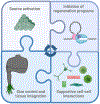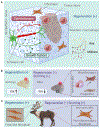Hallmarks of regeneration
- PMID: 39163854
- PMCID: PMC11410156
- DOI: 10.1016/j.stem.2024.07.007
Hallmarks of regeneration
Abstract
Regeneration is a heroic biological process that restores tissue architecture and function in the face of day-to-day cell loss or the aftershock of injury. Capacities and mechanisms for regeneration can vary widely among species, organs, and injury contexts. Here, we describe "hallmarks" of regeneration found in diverse settings of the animal kingdom, including activation of a cell source, initiation of regenerative programs in the source, interplay with supporting cell types, and control of tissue size and function. We discuss these hallmarks with an eye toward major challenges and applications of regenerative biology.
Keywords: regeneration.
Copyright © 2024 Elsevier Inc. All rights reserved.
Conflict of interest statement
Declaration of interests The authors declare no competing interests.
Figures






References
Publication types
MeSH terms
Grants and funding
LinkOut - more resources
Full Text Sources

